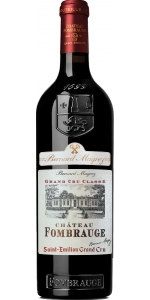Wine from Fombrauge
The estate goes back to the 16th century, which makes it one of the oldest châteaux in the Saint Emilion region. The first harvests were carried out in 1599. The origin of the name “Fombrauge” comes from the old Occitan terms “fons brogiera”, which means “spring surrounded by heather and bushes”. The spring and its fountain still exist today, powerfully masonry in cut stone in the heart of the estate's vines. Originally spelled “Fontbrauge” or “Fonbrauge” interchangeably, it was in the 19th century that the current spelling “Fombrauge” was formalized.
The beautiful 17th century old country manor was originally the cloister of the town’s Carthusian Monastery. Owned by Jacques de Canolle in 1466, the estate later belonged to the Dumas de Fombrauge family, who implemented the first quality winemaking in the estate in the 18th century. Jacques François Dumas inherited the estate in 1758 and the Taffard Saint-Germain family took it over in the 19th century and continued to develop the vineyards.
Bernard Magrez bought the estate in 1999 and made the necessary investments to improve the property by restructuring the vineyard and the layout of the cellars, and restored the charterhouse and the gardens to magnifiy the reception venues. These renovations elevated Chateau Fombrauge to the highest level of quality and produce one of the greatest wines of Saint Emilion. In 2012, Château Fombrauge was promoted as Grand Cru Classé, rewarding the efforts of modernization and continuous improvements.
Fombrauge Saint Emilion is made from 96% Merlot and 4% Cabernet Franc.
Château Fombrauge 2020 has a dark red hue, intense fruit aromas and elegant tannins that offer a generous mouthfeel rarely seen in wine so young.
The nose reveals aromas of cherries, blackberries and raspberries, along with spicy notes.
On the palate, the wine i round, soft and silky. Its deep richness, matched with a nice freshness and a long and mellow finish, make it already a great Château Fombrauge, with a long ageing potential.
Chateau Fombrauge Saint-Emilion Grand Cru's food pairing
- back
Selected Options
Wineries
Categories
Pricing
Countries
Regions
Grape Types
Wineries
Organic/Free Shipping
All older vintage wines have been purchased from a single collectors cellar. Pictures can be requested before shipment.
Domaine de Beaurenard Chateauneuf-du-Pape Blanc is made from Clairette blanche & Rose, Grenache Blanc & Gris, Bourboulenc, Roussanne, Picpoul and Picardan.
Gold bright green color. Expressive nose with pear and stone fruits aromas (peach, apricot) with jasmine and roasted almonds notes. The mouth is smooth and fleshy like stone fruit we can smell, with a long a nice finish.
Review:
Always terrific, the 2023 Châteauneuf Du Pape Blanc is no exception, and readers who love vibrant, age-worthy Rhône whites can safely buy this cuvée in just about every vintage. Based on 30% Clairette, 20% Grenache Blanc, 25% Bourboulenc, 22% Roussanne, and splashes of Picardan and Picpoul Blanc, the 2023 reveals a medium gold hue as well as textbook aromatics of pear and orchard fruits intermixed with honeyed flowers, chalky minerality, and subtle green almond nuances. This balanced, medium-bodied, vibrant white is very much in the fresh, focused, yet still textured, approachable style of the vintage.
-Jeb Dunnuck 93 Points





